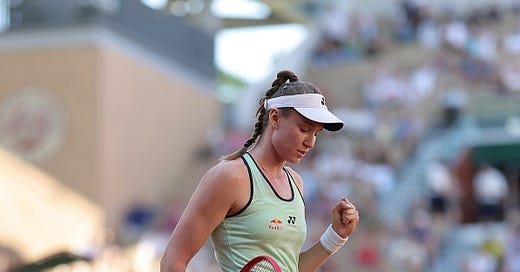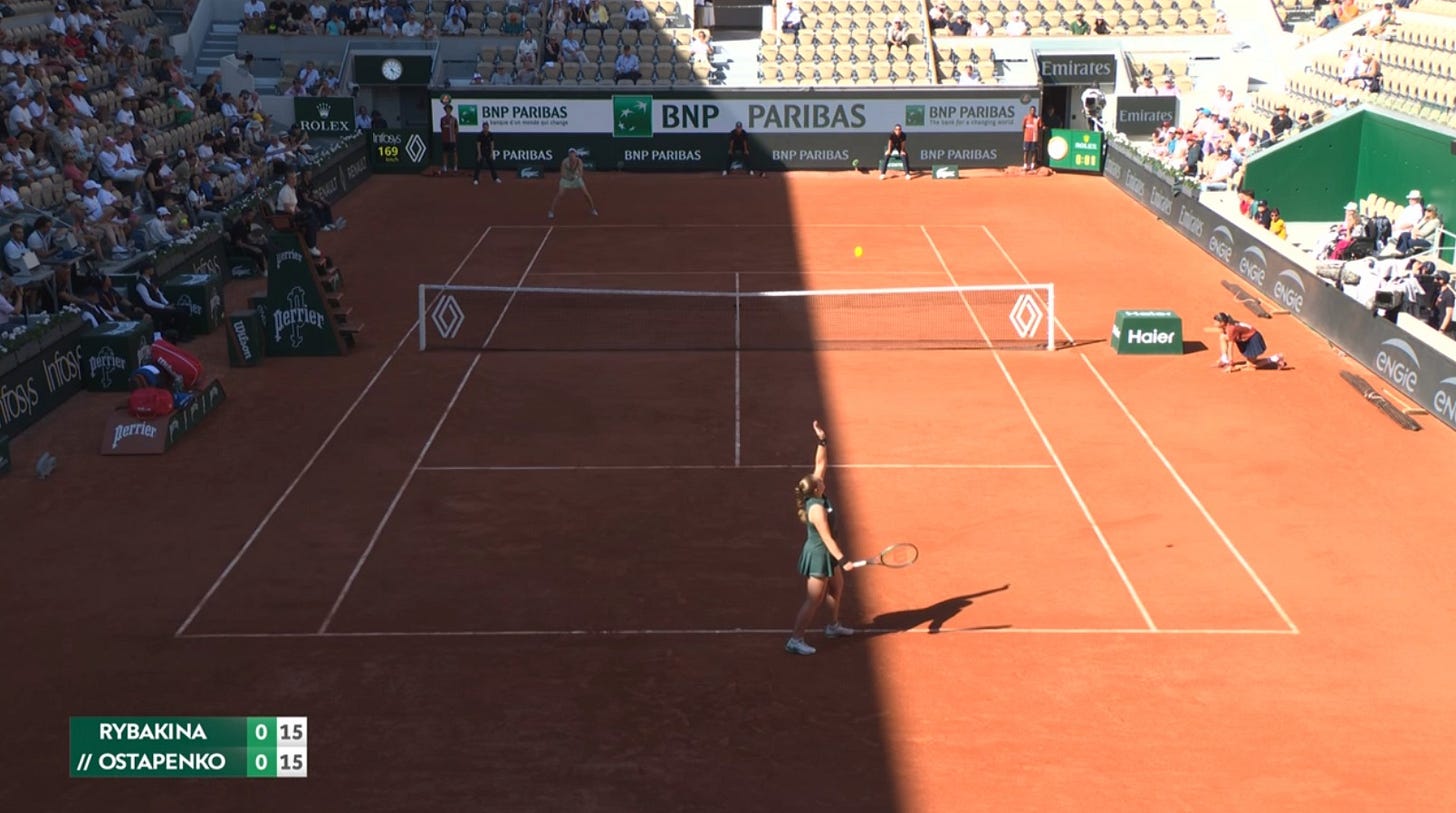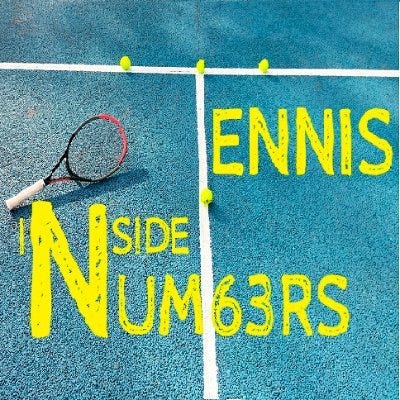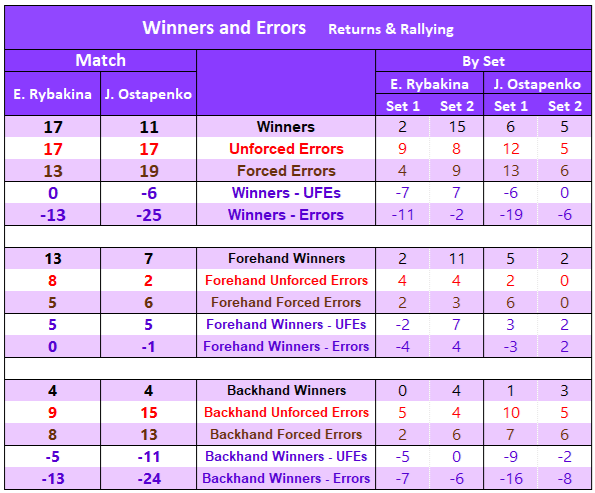Roland Garros: Elena Rybakina vs Jelena Ostapenko third round analysis
Two very different sets but the same relentless backhand attack
Elena Rybakina (WTA #12) and Jelena Ostapenko (WTA #21) faced off in the most exciting third round match of the 2025 French Open. A big hitting duel that delivered two very different sets and a fairly comfortable 6-2, 6-2 win for Rybakina.
First Set
The first set was all about Ostapenko’s bad start to the match… and points.
During a strange 11-minute, 6-Deuce opening game, Ostapenko struggled with her ball toss and the shade on the Deuce side. It led to 5 double faults and a confidence loss on her 2nd serves that persisted for the rest of the match.
After being offered so many chances to grab an initial break, Rybakina finally came through with a pair of winning “return+1” crosscourt forehands.
📺 source: Eurosport / Max
The Kazakh consolidated the lead with an ace to close out her inaugural serve game. Remarkably, she would strike just 1 more winner for the rest of the set, to finish with 3.
Despite only landing 6 of 21 (29%) 1st serves, Rybakina had little trouble winning the opener. She kept her groundstrokes deep, avoided going for too much and simply took advantage of her opponent’s early-rally implosion.
In the first set, Ostapenko missed her first shot (serve or return) 15 times and her second shot (“serve+1” or “return+1”) 13 times. That’s 28 quick points for Rybakina in a set she won a total of 35 points.
First set errors
Serve (DFs): Rybakina 2 / Ostapenko 7
Return: Rybakina 5 / Ostapenko 8
“Serve+1”: Rybakina 2 / Ostapenko 7
“Return+1”: Rybakina 2 / Ostapenko 6
Fans feeling disappointed the first set had lacked any sort of rhythm were correct: 52 of 59 (88%) of the points played were decided within the first 4 shots, with the majority ending on errors.
Second Set
Fortunately, the quality of the match picked up significantly in the second set. Ostapenko improved by cutting down unforced errors from 19 to 6. Rybakina shut the door to any comeback by bumping winners from 3 to 20.
It all started with these clean “return+1” strikes from Rybakina.
Despite squandering an initial 0/40 lead, the Kazakh still maintained a stranglehold on the match by engineering a break with a pair of forehand winners from Deuce.
Rybakina’s strong start to the set continued as she came up with a beautiful line backhand winner and a trio of aces in the second game, for another 2-0 lead.
At 1-3, the Kazakh erased a game point and then secured a two-break cushion with 3 winners in a row (a couple of big returns and an overhead from the baseline).
Ostapenko finally translated her improved play into something in the 6th game, breaking Rybakina’s serve for the first time in the match. She got the job done with a perfectly measured angled forehand, after avoiding falling 1-5 down with her own backhand return winner.
In the following game, at 2-4 40/30, Ostapenko held a chance to further increase her momentum. But Rybakina squashed the Latvian’s hopes with a powerful return that set up an easy putaway. She followed it with a crosscourt forehand winner at Deuce, creating a break point that turned out to be the last of the match (converted when Ostapenko netted a routine backhand).
Serving out the contest in style, Rybakina strung 4 consecutive winners after starting 0/30 down.
Final match data emphasized how much Rybakina’s win was built on applying pressure on Ostapenko’s backhand.
In total, the Latvian struck a backhand in 79 out of 106 returns and rally groundstrokes she hit during the match. That’s 75%!
Returns and groundstrokes hit
Rybakina: 45 forehands / 74 backhands
Ostapenko: 27 forehands / 79 backhands
Rybakina’s strategy paid off big-time as Ostapenko accumulated 28 backhand errors and performed 17 points worse from that wing (-21 to -4). A huge gap that created most of the final difference.
Backhand Performances
Rybakina: 4 winners + 9 forcing / 17 errors = -4
Ostapenko: 4 winners + 3 forcing / 28 errors = -21

Remarkably, Ostapenko finished the match with just 2 forehand unforced errors. And during rallies, she only missed 4 total forehands.
These are surprising stats that carry little meaning as Rybakina wasn’t sending many balls towards Ostapenko’s forehand and the Kazakh’s flat and deep shots weren’t giving any time for the Latvian upgrade backhands to run-around forehands.
Forehand Performances
Rybakina: 13 winners + 5 forcing / 13 errors = +5
Ostapenko: 7 winners + 4 forcing / 8 errors = +3

Rybakina’s tactics were particularly relevant on her returns and how she was able to influence Ostapenko’s “serve+1” performance.
Whenever Ostapenko hit a forehand after landing serve — and it only happened after landing a 1st serve — she managed to win all 6 points. Otherwise, Ostapenko’s win-rates hovered around 25% when Rybakina made her hit “serve+1” backhands.
Ostapenko win-rates
After a 1st serve
“serve+1” FH: 6-for-6, 100%
“serve+1” BH: 3-for-11, 27%
After a 2nd serve
“serve+1” FH: 0
“serve+1” BH: 1-for-5, 20%
Ostapenko ripped 5 “serve+1” winners with no errors from the forehand wing. But she accumulated 12 errors from the backhand wing, with just 2 winners to compensate.
Ostapenko “Serve+1” Performance
Forehand: 5 winners / 0 errors = +5
Backhand: 2 winners / 12 errors = -12
Coupled with Rybakina’s pair of return winners, Ostapenko 12 “serve+1” backhand errors created a 10-point gap in 2-shot rallies that was the biggest in the match (marked by red box below).
Next up for Rybakina will be a 9th career meeting with defending champion Iga Swiatek. Their head-to-head currently stands at 4-4. Swiatek is 2-0 this season; Rybakina is 2-0 on clay.
Fresh off a title in Strasbourg, Rybakina is on a 7-match win streak and playing her best tennis of the season.
A very tough challenge for Swiatek and her 24-match win streak at the French Open, but the lesser evil the Pole was ready to take on — and laugh about — instead of facing Ostapenko and the mentally-crushing 0-6 record.
Swiatek-Rybakina match analyses in our archives:
Elena Rybakina (WTA #12, seed 12) vs Jelena Ostapenko (WTA #21, seed 21)
2025 Roland Garros third round - Match Data
Set by Set Stats
Strategy Stats
Strokes Breakdown

Winners and Errors (returns & rally shots)
Direction of winning shots and unforced errors (only groundstrokes)

Serve and Return
1st Serves
2nd Serves
Return & rallying performance
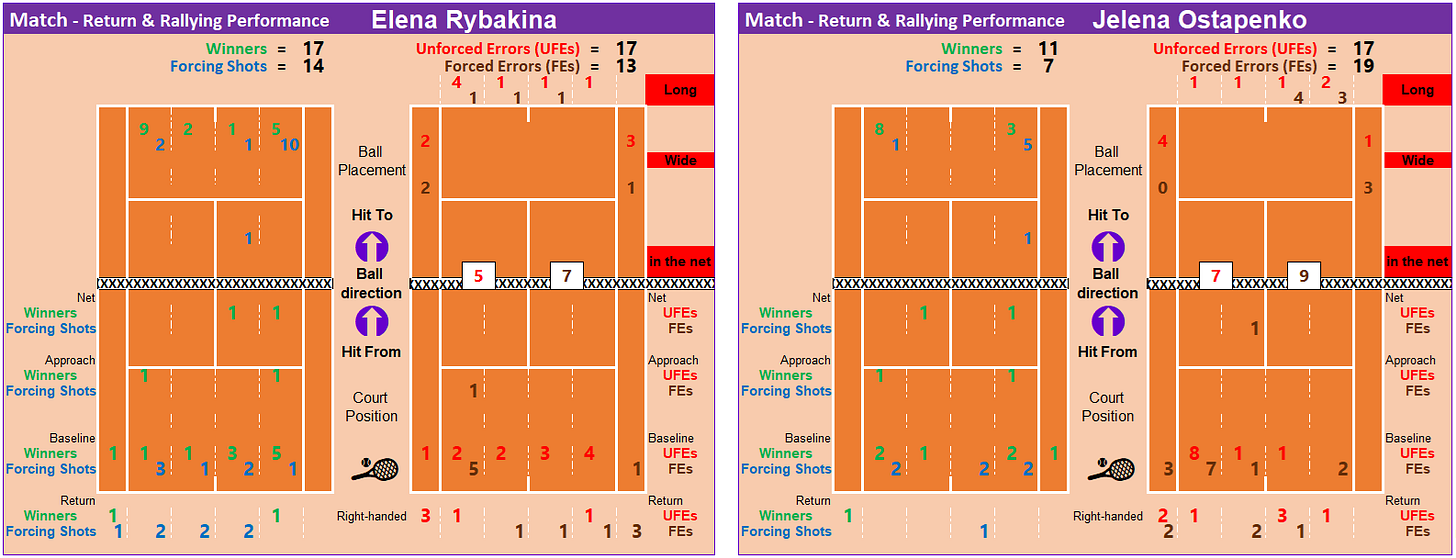
Rally length
Points won breakdown
This final section gives a last, broader look at the match by presenting how each player won points. Points are listed according to their frequency (highest to lowest) and are named in relation to the last touch on the ball. For simplicity, groundstrokes hit from the 5th shot onwards are grouped together.
Breakdown by side (FHs or BHs)

Breakdown by error type (UFEs or FEs)

To find out more about the stats published here, please visit the following post.
While we follow the same criteria used on all major tennis events, our stats are collected through our own video analysis and are not official WTA or ITF stats.
Thanks for reading!
— Tennis Inside Numbers

